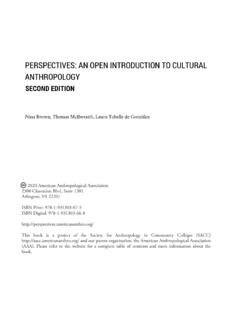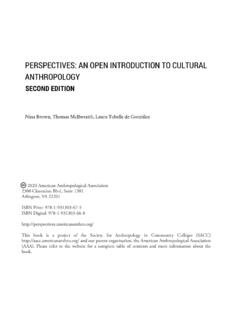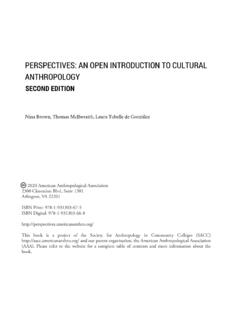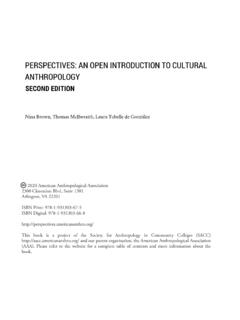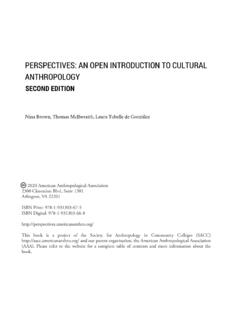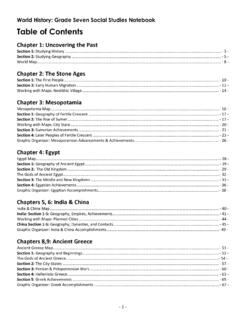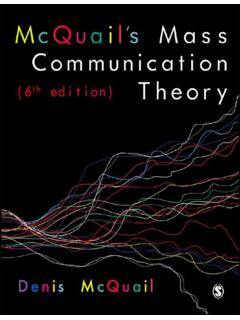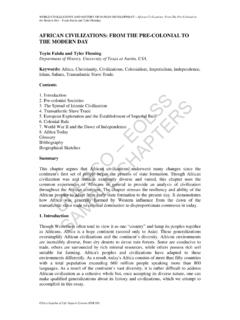Transcription of Perspectives: An Open Introduction to Cultural Anthropology
1 PERSPECTIVES: AN OPEN Introduction TO Cultural . Anthropology . SECOND EDITION. Nina Brown, Thomas McIlwraith, Laura Tubelle de Gonz lez 2020 American Anthropological Association 2300 Clarendon Blvd, Suite 1301. Arlington, VA 22201. ISBN Print: 978-1-931303-67-5. ISBN Digital: 978-1-931303-66-8. This book is a project of the Society for Anthropology in Community Colleges (SACC). and our parent organization, the American Anthropological Association (AAA). Please refer to the website for a complete table of contents and more information about the book. Perspectives: An Open Introduction to Cultural Anthropology by Nina Brown, Thomas McIlwraith, Laura Tubelle de Gonz lez is licensed under a Creative Commons Attribution-NonCommercial International License, except where otherwise noted. Under this CC BY-NC copyright license you are free to: Share copy and redistribute the material in any medium or format Adapt remix, transform, and build upon the material Under the following terms: Attribution You must give appropriate credit, provide a link to the license, and indicate if changes were made.
2 You may do so in any reasonable manner, but not in any way that suggests the licensor endorses you or your use. NonCommercial You may not use the material for commercial purposes. 12. GLOBALIZATION. Lauren Miller Griffith, Texas Tech University Jonathan S. Marion, University of Arkansas Learning Objectives Define globalization and the 5 scapes that can be used to characterize global flows or exchanges. Explain the relationship between globalization and the creation of new glocal lifestyles and forms of consumption. Describe some of the ways people use agency to respond to globalization including syncretism and participation in alternative markets. Assess the relationship between globalization, neoliberalism, and neocolonialism. Evaluate the advantages and disadvantages of the intensification of globalization.
3 Discuss the implications of globalization for Anthropology . It is Tuesday on campus as you enter the dining hall. The day's hot lunch entr es include Caribbean jerk pork with mango salsa and a side of collard greens. The next station is offering made-to-order Asian stir-fry. At the sandwich counter, tuna salad, an all-American classic, is being served in a pita. Now, are these dishes authentic? That, of course, depends on how you define A similar question was asked at Oberlin College in December 2015 when a group of students claimed that adapt- 304. 305. ing foreign cuisines constituted a form of social Their claim, which raised a great deal of con- troversy, was that the cafeteria's appropriation and poor execution of ethnic dishes was disrespectful to the cultures from which those recipes were taken.
4 Many people dismissed the students' concerns as either an overreaction or as an attempt to rephrase a perennial complaint (bad cafeteria food) in a polit- ically loaded language of social justice likely to garner a response from the administration. Regardless of what one thinks about this case, it is revealing of how college campuses as well as the larger societies in which they are situated have changed over time. The fact that dishes like sushi and banh mi sand- wiches are even available in an Ohio college cafeteria suggests that globalization has intensified. The fact that the students would be reflexive enough to question the ethical implications of appropriating foreign cuisine suggests that we are truly in a new era. But what, in fact, is globalization? OVERVIEW AND EARLY GLOBALIZATION. Globalization is a word commonly used in public discourse, but it is often loosely defined in today's society (much like the word culture itself).
5 First appearing in the English language in the 1940s, the term globalization is now commonplace and is used to discuss the circulation of goods, the fast and furious exchange of ideas, and the movement of Despite its common use, it seems that the many people using the term are often not defining it in the same way. Some treat globalization as sim- ply an economic issue while others focus more on the social and political aspects. What is clear, how- ever, is that globalization has influenced many different facets of contemporary social life. This actually makes globalization an ideal topic of study for anthropologists, who pride themselves on taking a holis- tic approach to culture (see the Development of Anthropological Ideas chapter ). For our purposes, we adopt political scientist Manfred Steger's definition of globalization: the intensification of worldwide social relations which link distant localities in such a way that local happenings are shaped by events occurring many miles away and vice versa.
6 4. It is challenging to determine precisely when globalization began. Although some people discuss globalization as if it was an entirely new process without historical antecedents, in truth its precursors have been going on for a very long time. In this chapter , we argue that the distinguishing feature of globalization in the contemporary era is the speed, rather than the scope, of global interactions. Early modern technological innovations hastened For instance, the invention of the wheel cre- ated a need for permanent roads that would facilitate transport of animal drawn carts. These wheeled vehicles increased people's mobility, which in turn facilitated the sharing of both goods and ideas. Even before the invention of the wheel, the creation of written communication systems allowed ideas to be shared between people in distant locations.
7 Certainly extensive empires have existed at various times throughout human history, including Chi- nese dynasties (the Han dynasty, 206 BCE-220 CE, for instance, reached the same size the Roman Empire achieved much later); the Ottoman Empire, and the Roman Empire. Most recently in world history, European colonial expansion into Africa, Asia and the Americas marked another landmark of globalization. As discussed in the Development of Anthropological Ideas chapter , colonialism refers to the political, social, economic, and Cultural domination of a territory and its people by a foreign power for an extended period of time. Technically, colonialism can be practiced by any group that is pow- erful enough to subdue other groups and this certainly would be an accurate term for Ottoman and Roman imperial expansion but as a term, colonialism is typically associated with the actions of Euro- pean countries starting in the 1500s and lasting through the 1900s.
8 During this period, European colo- 306 PERSPECTIVES: AN OPEN Introduction TO Cultural Anthropology . nial powers divvied up unclaimed land with little regard for ethnic groups who already lived in those places, their political structures, belief systems, or lifeways. By 1914, European nations ruled more than 85 percent of the world, and it is not by accident that the image of the world most often seen on con- ventional maps continues to be very Eurocentric in its orientation (see map). Colonialism in the Americas was the result of European conquest of newly discovered territories during the Age of Exploration. Columbus was likely not the first explorer to reach the Americas, but his discovery intensified Europeans' desires to colonize this new territory. European leaders began expanding their spheres of influence in Europe before turning their attention to lands further afield; the successes they had in colonizing nearby lands, amplified by a growing demand for trade items found in the Orient, fueled their enthusiasm for exploration outside the region.
9 The Catholic Church also sup- ported this economically motivated mission, as it coincided with a weakening of their religious-strong- hold in places like England, Germany, and France. One of the most devastating features of the colonial period was the forced labor of both indigenous Americans and Africans who were enslaved and shipped off as chattel. Between 1525 and 1866, million slaves were sent to the New World from Africa. Treated as chattel, only million Africans survived until arriving in the Americas. The imported approximately 450,000 of these slaves. It is not by coincidence that the ethically irredeemable shipment of slaves to the Americas corresponded to massive shipments of goods to Europe and down the west coast of Africa. As far as the total scope of international flows, however, European colonialism pales in comparison to the scope of globalization that has transpired since the 1990s.
10 Contemporary globalization, at least in terms of economics, is perhaps best pinpointed as coinciding with the conclusion of World War II and the Bretton Woods The agreements made at the Bretton Woods Conference led to the creation of the International Monetary Fund (IMF) as well as the International Bank for Reconstruction and Development, which later became the World Bank (WB). It also laid the groundwork for the World Trade Organization (WTO). Taken together, these three orga- nizations have had a tremendous role in accelerating globalization and in shaping the lives of people in the developing world. The very idea of governing bodies like the United Nations, or regulatory institu- tions like the IMF and WB, that exist outside the confines of a specific nation-state now widely refer- enced as Non-Governmental Organizations (NGOs) contributes to undermining local Although local, regional, and national identities and affiliations retain salience in the global era, their importance has shifted relative to the growing sense many people have of being citizens of the world.

